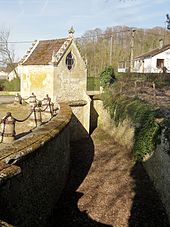Haha

A Ha-Ha or Aha is a design element in gardening . The Ha-Ha replaces a visible park wall or fence. It is designed as a dry, deep ditch well below ground level with steep embankments or as a wall standing in a ditch, supporting the ground on one side or free-standing (double Ha-Ha). A border ditch lined with steep walls is called saut-de-loup (“wolf jump”).
A Ha-Ha prevents animals and uninvited visitors from entering the garden without a wall blocking the view of the site and the surrounding landscape. This can make the garden look bigger.
Origin of the word
The English expression Ha-Ha , which has also become common in German, is explained by the onomatopoeic exclamation of astonishment. The Ha-Ha, not recognizable from a distance, only becomes visible when approaching, amazes the visitor, who often surprises the construction with "Ha-ha!" Or "Aha!"
The word originally referred to an obstacle that blocked a path or a path that ended as a dead end. It then went over to the design element in the English landscape gardens of the 18th century ( sunk fence , "lowered fence").
history
Ha-has have been used by horticulturalists since the early 18th century. Antoine-Joseph Dezallier d'Argenville explained in his contemporary work La théorie et la pratique du jardinage (Paris 1709; "The theory and practice of horticulture") the construction of a ha-has. Dezallier saw in the wall opening that allowed a clear view an improvement over an iron grating (a claire-voie , "free view"). Stephen Switzer published a first sketch . Horace Walpole attributed the earliest realization to William Kent and praised Charles Bridgeman for the use of the ha-has. The idea of creating a wall opening in the enclosure of a garden by means of a barrier ditch with a lowered obstacle originated from the baroque era ; it became more common with the creation of gardens in the English style .
Around 1695 a French gardener laid out the first (still small) Ha-Ha in England in Levens Hall . Today, public buildings are occasionally "discreetly" protected with a Ha-Ha from unwanted access, for example in the context of political demonstrations (plenary hall of the Schleswig-Holstein state parliament in the state house of Kiel , new building for the European Central Bank ).
Examples in palace gardens
In the Nymphenburg Palace Park in Munich there are four Ha-Has (traditionally called "Aha" here) as extensions of the large views and meadow valleys. Further examples can be found in the park of Schloss Benrath in Düsseldorf and on the Lower Rhine in the forest garden of Kleve . The semicircular garden of Karlsruhe Palace is also separated from the adjoining Hardt Forest on the north and east by a ha-ha, here as a ditch with a wall filled in on the inside . The Pillnitzer Schlosspark in Dresden has a ha-ha to the west. From the Parc de Bagatelle near Paris, a ha-ha allows a view of the Bois de Boulogne .
On the southern edge of the Hermitage (Bayreuth) there is still a depression in the terrain which, as Haha, has been separating the park landscape from the adjoining fields since the 18th century. In terms of landscape design, Ha-Has are also combined with other elements ( e.g. point de vue at the end of a visual axis , in reality interrupted by an invisible ditch; or an eye-catcher standing outside the garden , an eye- catching tower or individual tree).
"Wolfsgrube", saut-de-loup

Lined recesses in front of castles such as the Grand Trianon in Versailles or the city palace Hôtel de Sully in Paris are known as saut-de-loup . The ditch, too wide to be jumped over by a wolf (after Michel Conan), can be spanned by a bridge ( wolf pit ) or it can be at the end of an avenue or interrupt it in order to prevent access from outside. Such a moat was also dug in front of Bellevue Palace . Clarification of sauts-de-loup by Ha-Has appears arbitrary.
literature
- Antoine Josephe Dezallier d'Argenville : La théorie et la pratique du jardinage or l'on traite à fond des beaux jardins. Jean Mariette , Paris 1709, pp. 73–74 (in part 1, chap. 8).
- Horace Walpole : About English Garden Art. Manutius-Verlag, Heidelberg 1993, ISBN 3-925678-35-2 .
- Michel Conan : Dictionnaire historique de l'art des jardins . Hazan, Paris 1997. ISBN 2-85025-543-2 , p. 123 (“ Haha ou ahah ”) , p. 209 (“ Saut-de-loup ”) .
- Dorothy Stroud : Ha-ha . In: The Oxford companion to gardens , edited by Patrick Goode, Michael Lancaster . Oxford, New York 2001, ISBN 0-19-860440-8 , p. 241.
Web links
Footnotes
- ↑ Bill Bryson: A Brief History of Everyday Things. Goldmann Verlag, Munich 2011, ISBN 978-3-442-30122-5 .
- ↑ full text


